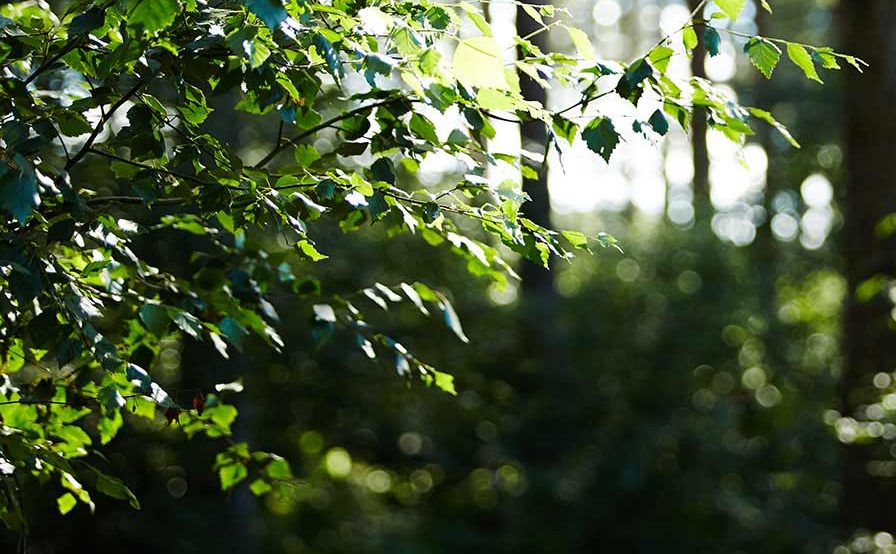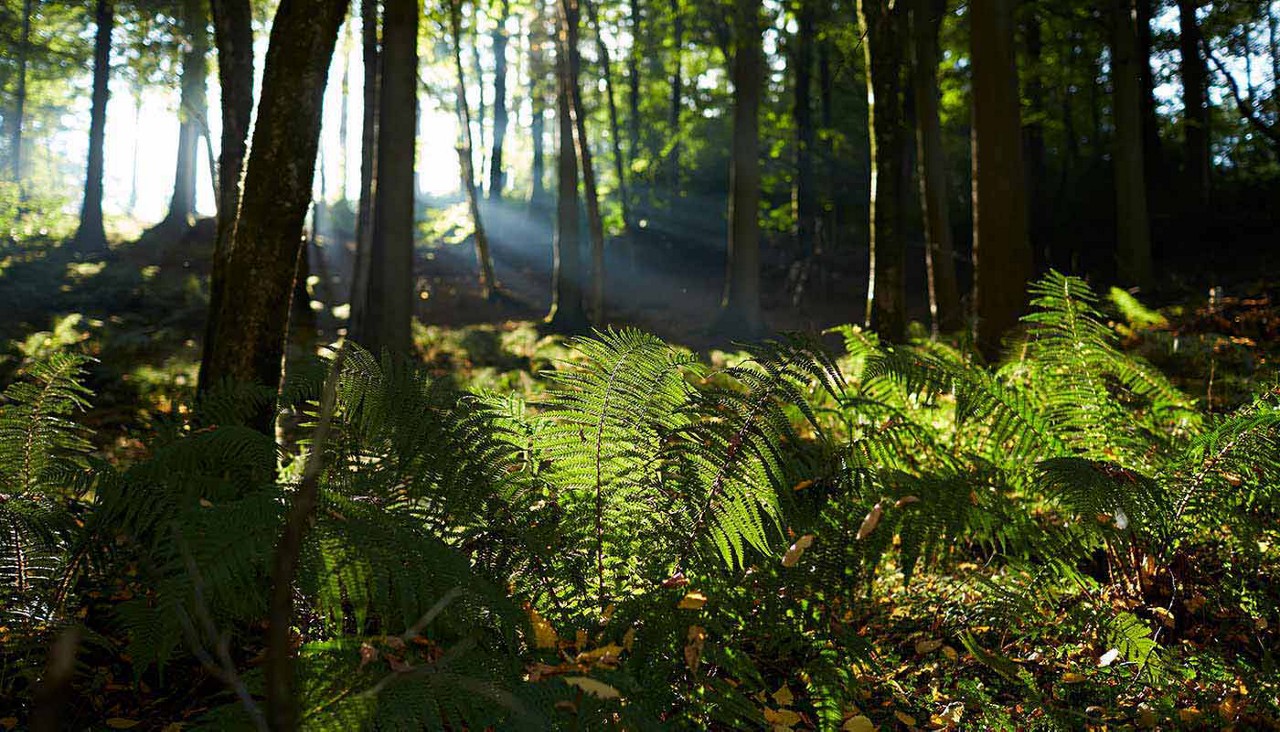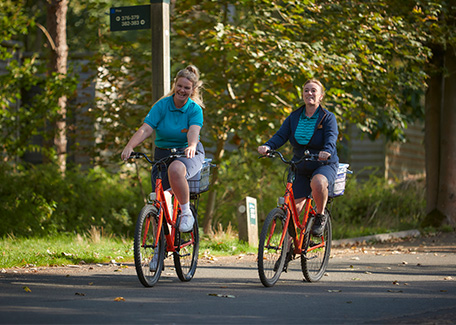We know that reducing carbon emissions is critical in the effort to combat climate change, and we’re setting ambitious targets for ourselves in this area. We’ve already made good progress, reducing our carbon emissions by 20% since 2010, but we now want to go even further.
Our target is to reduce our carbon emissions by 30% by 2030 from a baseline year of 2020.
Where we are
- We’ve switched our grid electricity to 100% renewable energy, reducing our carbon footprint by 21% and saving more than 13,000 tonnes of carbon each year
- At Sherwood Forest, renewable biogas from a nearby anaerobic digestion plant is piped directly to our village and used to generate around 80% of the electricity we use. This biogas also provides most of the heat for our Subtropical Swimming Paradise and Aqua Sana Forest Spa.
- At Woburn Forest, our entire village (including all lodges, the Subtropical Swimming Paradise, Aqua Sana Forest Spa, The Venue and all central buildings) are connected to a district heating network, which is supplied with heat from sustainably sourced woodchip, topped up with heat from natural gas as required. This means that all lodges at Woburn Forest are off the gas grid and supplied with 100% district heat and renewable electricity
- We’ve switched to low energy lighting in all our central buildings and lodges
- Wherever possible, we’ve replaced the grilling equipment in our restaurant kitchens and refrigeration equipment in our ParcMarkets with energy-efficient and low-carbon alternatives
- We’re well on track to replace our entire fleet with electric or hybrid vehicles by 2030 and now offer 100 electric vehicle charging points at each village for guests to use. These units are supplied with zero carbon renewable electricity), so guests using electric vehicles can drive home carbon free
- While the forest is not the best place for solar power, we have some solar power installed to generate renewable energy at four of our villages and our head office building – Forest House
- We use ground and air source heat pumps to provide heat and hot water to several buildings at Whinfell Forest, Sherwood Forest (including Santa’s Woodland Workshop) and a number of lodges at Longleat Forest and Elveden Forest
Where we're going
- We’re planning to install more air source heat pumps as we add or renovate buildings. The largest installation currently planned is at Longford Forest in Ireland, where we’re adding 198 new lodges. The heating supply for these lodges will focus on district heating from a large central air source heat pump. As this system will be powered by 100% renewable, zero carbon electricity, the energy supply to these lodges will be extremely low carbon
- We’ll continue to transition our fleet to 100% electric or hybrid vehicles as we replace vehicles
- To reduce the carbon impact of our restaurants, where possible we’re shifting from using gas to using electricity in our kitchens
- While we know most guests arrive by car, we’ve added helpful information on our booking portal to let guests know about nearby sustainable travel options, such as the distance to local train stations and, in some cases, bus transfers
- For Woburn Forest, Thameslink offer a discount for those travelling to Center Parcs
- We’re working with our largest suppliers, with support from Nottingham Trent University, to encourage and support them to reduce their emissions
How we're doing
We’re aiming to reduce the carbon emissions from our villages and Forest House by 30% by 2030.
Figure 1 shows the total reported scope 1 and scope 2 carbon emissions (emissions associated with energy consumption and fuels used on site and for business travel) for our UK and Ireland operations. This shows that our carbon emissions remain below the baseline for both our UK and Ireland operations.
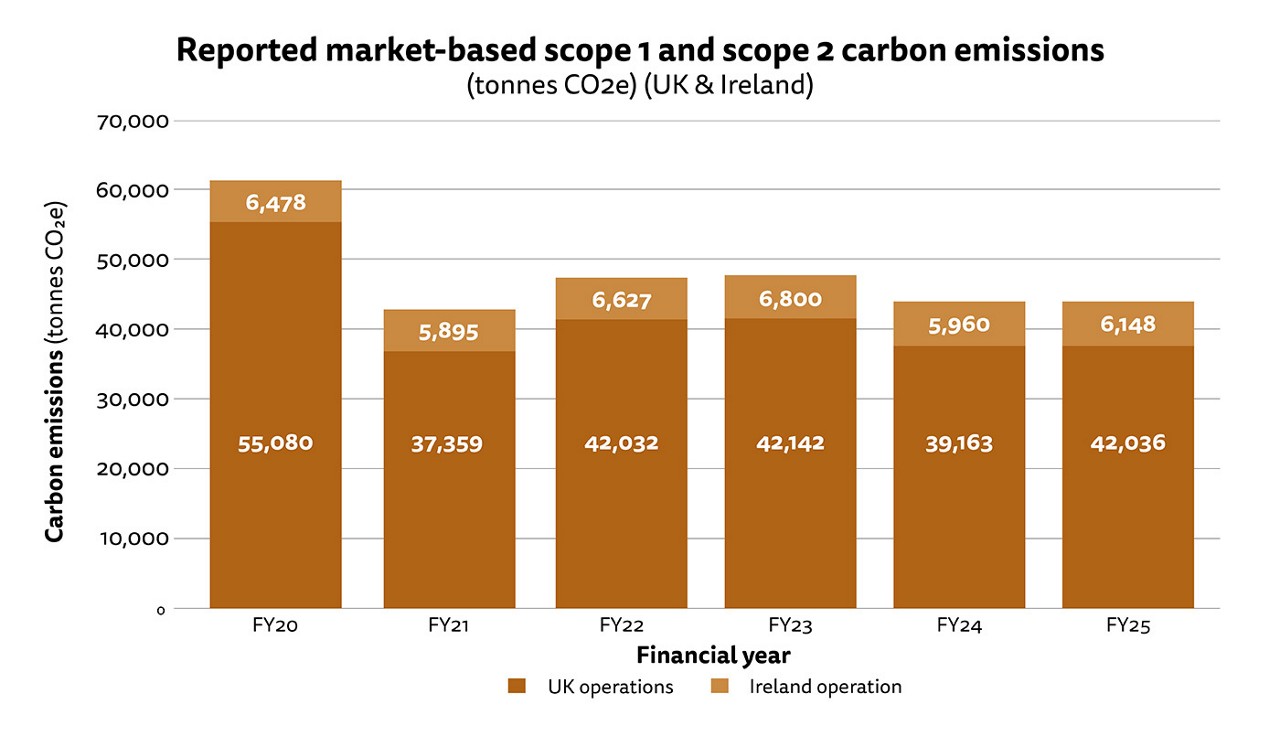 Figure 1: Stacked bar chart showing reported market-based scope 1 and scope 2 carbon emissions in tonnes CO2e for our UK and Ireland operations
Figure 1: Stacked bar chart showing reported market-based scope 1 and scope 2 carbon emissions in tonnes CO2e for our UK and Ireland operations
Figure 2 shows the total reported scope 1 and scope 2 carbon emissions for our UK operations and monitors progress against our 2030 target. This shows that we’re achieving a reduction in line with the required rate of reduction to achieve our 2030 target. So far, we’ve reduced our emissions by 24% compared to a baseline year of 2020.
 Figure 2: Bar chart showing reported market-based scope 1 and scope 2 carbon emissions in tonnes CO2e for our UK operations
Figure 2: Bar chart showing reported market-based scope 1 and scope 2 carbon emissions in tonnes CO2e for our UK operations
Both charts depict our market-based emissions. The below figures show our full year emissions in tonnes CO2e based on a location-based factor (the UK National Grid average carbon intensity) rather than a market-based factor (the carbon intensity for the certified zero-carbon renewable power that we use):
UK operations (location-based)
- FY20: 55,080 tonnes CO2e
- FY21: 42,754 tonnes CO2e
- FY22: 51,259 tonnes CO2e
- FY23: 51,533 tonnes CO2e
- FY24: 42,754 tonnes CO2e
- FY25: 52,029 tonnes CO2e
Ireland operation (location-based)
- FY20: 6,478 tonnes CO2e
- FY21: 7,268 tonnes CO2e
- FY22: 8,878 tonnes CO2e
- FY23: 9,488 tonnes CO2e
- FY24: 8,525 tonnes CO2e
- FY25: 8,162 tonnes CO2e
- Figures for FY20, FY21 and FY22 were affected by closures of the villages and operational restrictions due to the Covid-19 pandemic and therefore do not reflect a typical year of operations.
- Figures for FY20, our baseline year, have been adjusted to account for 35 days of closure due to the Covid-19 pandemic – this adjustment allows us to reasonably set FY20 as a baseline year for our targets, ensuring we reflect a typical operating year.
- Due to the timing of when Center Parcs Longford Forest (in Ireland) opened, and the closures due to the Covid-19 pandemic, FY24 was the first full year of figures for our Ireland operation. With this in mind, we have not yet set targets for our Ireland operation and so our carbon emissions target solely applies to our UK operations at this time. We are committed to making real reductions to our carbon emissions and we hope to be able to set targets for our Ireland operation soon.
- FY20: 55,080 tonnes CO2e
- FY21: 37,359 tonnes CO2e
- FY22: 42,032 tonnes CO2e
- FY23: 42,142 tonnes CO2e;
- FY24: 39,163 tonnes CO2e;
- FY25: 42,036 tonnes CO2e
Ireland
- FY20: 6,478 tonnes CO2e
- FY21: 5,895 tonnes CO2e
- FY22: 6,627 tonnes CO2e
- FY23: 6,806 tonnes CO2e
- FY24: 5,960 tonnes CO2e
- FY25: 6,148 tonnes CO2e
The chart shows the total reported scope 1 and 2 carbon emissions for our UK and Ireland operations in tonnes CO2e. The chart shows that total emissions for FY21, FY22, FY23, FY24 and FY25 were below emissions for FY20.
- FY20: 55,080 tonnes CO2e
- FY21: 37,359 tonnes CO2e
- FY22: 42,032 tonnes CO2e
- FY23: 42,142 tonnes CO2e;
- FY24: 39,163 tonnes CO2e
- FY25: 42,036 tonnes CO2e
- FY30 target: 38,556 tonnes CO2e
The chart shows the total reported scope 1 and 2 carbon emissions for our UK operations in tonnes CO2e. There is a trendline from FY20 to FY30, showing that a reduction of 16,524 tonnes CO2e is required to reach our FY30 target. The chart shows that the average annual emissions reduction achieved since FY20 is well ahead of our target trajectory.
Carbon emissions by source
We believe it's important to review the bigger picture in terms of carbon emissions, so that we can understand where to target our efforts to make the greatest impact.
Figure 3 shows the total reported scope 1 and scope 2 carbon emissions for our UK and Ireland operations in FY25. Our largest source of scope 1 and scope 2 carbon emissions is natural gas, accounting for 90% of emissions.
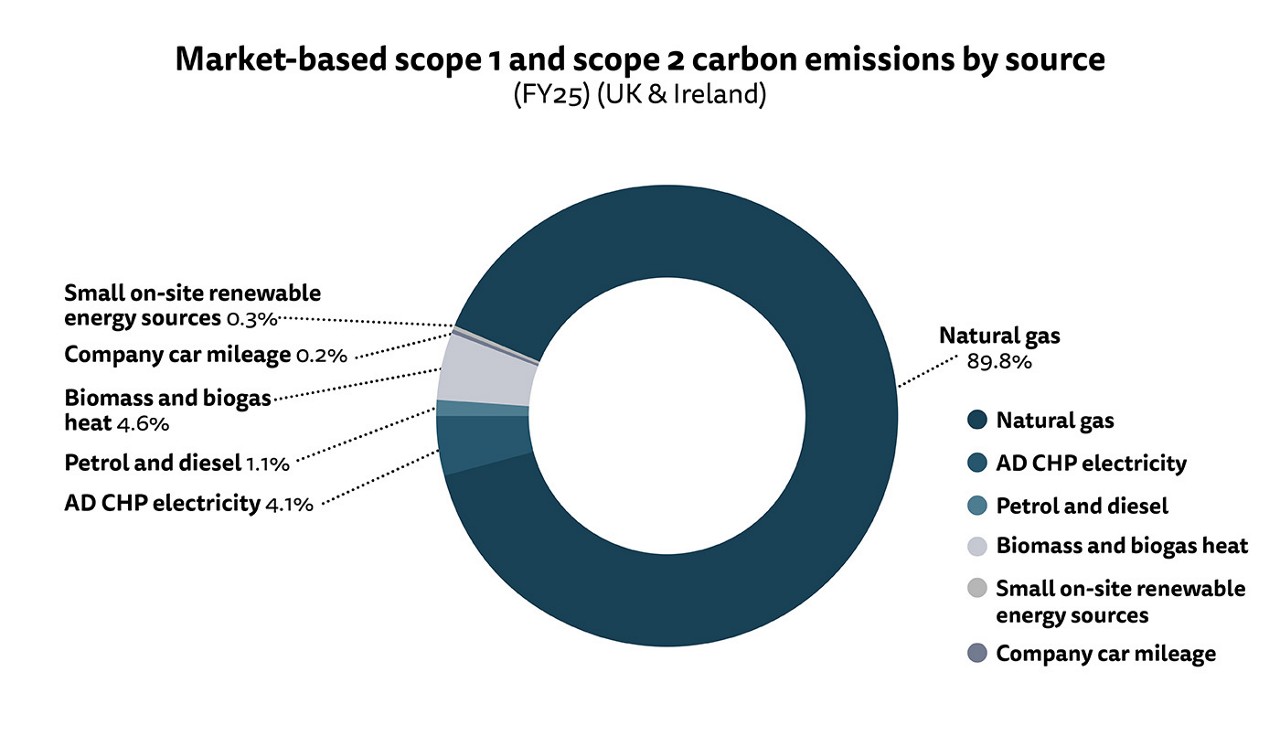 Figure 3: Pie chart showing market-based reported scope 1 and scope 2 carbon emissions by source for our UK and Ireland operations
Figure 3: Pie chart showing market-based reported scope 1 and scope 2 carbon emissions by source for our UK and Ireland operations
- In 2020 we switched to purchasing 100% renewable grid electricity – this electricity is from wind power and is backed by the Renewable Energy Guarantees of Origin (REGO) scheme. The scheme is administered in the UK and Northern Ireland by the energy regulator OFGEM.
- We also produce our own renewable energy using a biogas-powered combined heat and power (CHP) unit at Sherwood Forest, a wood-fuelled district heating network at Woburn Forest, and a 100KWp solar array on our Forest House building. In FY24, we also purchased the REGO certificates for the electricity generated by our biogas CHP unit. Combined, these initiatives have reduced our carbon emissions by around 13,000 tonnes.
- Natural gas: 89.8%
- Biomass and biogas heat: 4.6%
- Anaerobic digestion (AD) combined heat and power (CHP) electricity: 4.1%
- Petrol and diesel: 1.1%
- Small on-site renewable energy sources: 0.3%
- Company car mileage: 0.2%
The chart shows the scope 1 and 2 carbon emissions by source for our UK and Ireland operations. It shows that the largest source of carbon emissions is natural gas. A smaller amount comes from biomass and biogas heat, followed by electricity generated by a CHP unit powered by biogas produced through anaerobic digestion – REGO certificates were purchased for this for the first time in FY24 (June 2023). Smaller amounts still come from our use of petrol and diesel and small on-site renewable energy sources, Finally, a very small proportion comes from the fuel used in our company cars.
Carbon emissions relative to number of guests
It's important that we consider our carbon emissions in the context of our business to understand the impact our operational activity levels have. To do this, we measure carbon emissions per sleeper night (the number of guests visiting our villages each year).
Figure 4 shows reported scope 1 and scope 2 carbon emissions per sleeper night for our UK and Ireland operations.
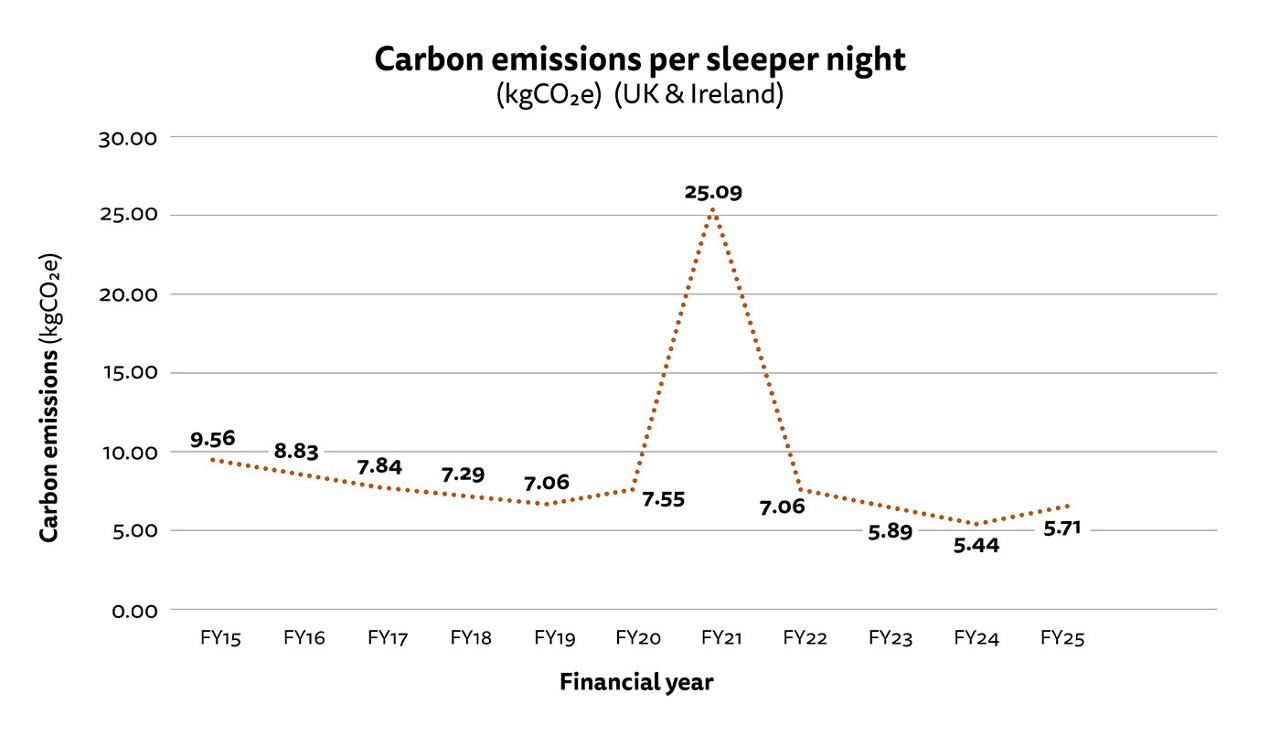 Figure 4: Line chart showing reported scope 1 and scope 2 carbon emissions per sleeper night for our UK and Ireland operations
Figure 4: Line chart showing reported scope 1 and scope 2 carbon emissions per sleeper night for our UK and Ireland operations
- Figures for FY20, FY21 and FY22 were affected by closures of the villages and operational restrictions due to the Covid-19 pandemic – although we had no guests (or were operating at a reduced occupancy) during these periods, we still needed to consume a certain amount of energy to ensure the safety and integrity of the buildings and wider sites.
- Figures for FY20 have been adjusted to account for 35 days of closure due to the Covid-19 pandemic – this adjustment allows us to reasonably set FY20 as a baseline year for our targets, ensuring we reflect a typical operating year.
- FY15: 9.56kg CO2e
- FY16: 8.83kg CO2e
- FY17: 7.84kg CO2e
- FY18: 7.29kg CO2e
- FY19: 7.06kg CO2e
- FY20: 7.55kg CO2e
- FY21: 25.09kg CO2e
- FY22: 7.06kg CO2e
- FY23: 5.89 kg CO2e
- FY24: 5.44 kg CO2e
- FY25: 5.71kg CO2e
The chart shows carbon emissions by sleeper night in kilograms of CO2e for our UK and Ireland operations. It shows a steady and sustained decrease from FY15 to FY19. In FY20, there is a small increase (due to the impact of the pandemic). In FY21, it sharply increases to almost three times the total for FY20 (attributed to reduced occupancy during the pandemic), before dropping back down to the same level as FY19 in FY22. FY23 and FY24 show further drops and are the lowest on the chart. FY25 saw a very slight increase compared to FY24.
